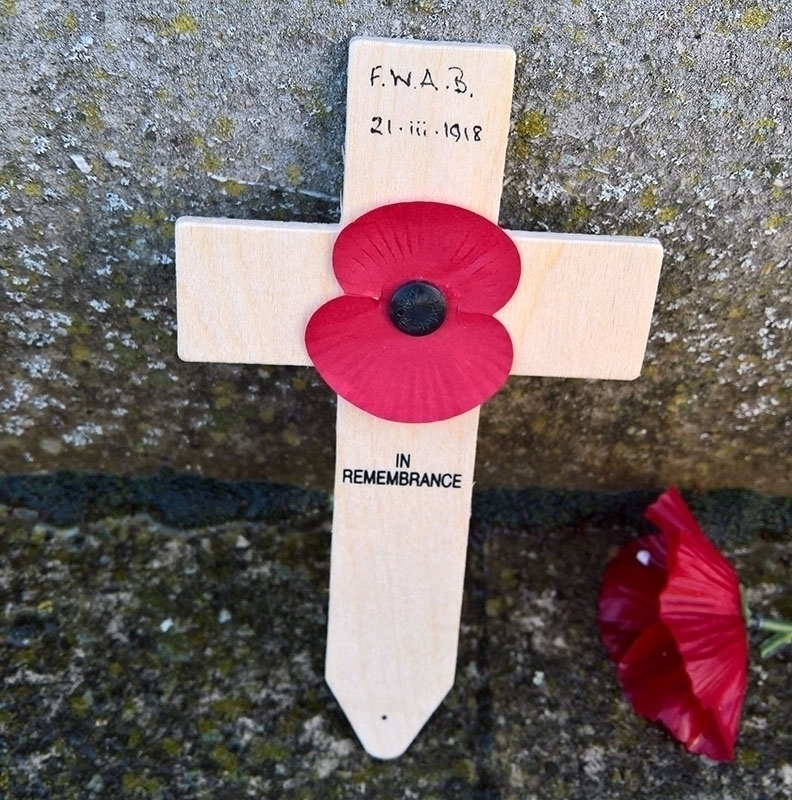Francis William Ashton Buckell (B.1889.2) was born on 20 May 1875 in Chichester, Sussex. He was the son of Dr. Leonard Buckell and Mary Augusta Duke, formerly Ashton. He had an elder sister Mary Noel Ashton Buckell and a younger brother Clyde Westmore Ashton Buckell. It was a second marriage for both of his parents, so he had an extended family of half-siblings.
Francis attended Haileybury between April 1889 and July 1892. His younger brother Clyde (B.1891.1) was also educated at Haileybury as was an elder half-brother Gilbert Ashton Duke (BF.1880.3).
Francis subsequently studied to be an architect, qualifying as an associate of the Royal Institute of British Architects in 1900. He also from sometime after leaving school and qualifying as an architect served as a private in the Honourable Artillery Company. In 1901 he was living with his brother Clyde in Ashworth Mansions, Maida Vale, London. Between 1906 and 1907 Francis travelled to Canada and the USA. By 1911 Francis and his brother were living at Weybridge, Surrey before spending a year in Kenya, returning to Britain in 1915.
Joining up
Despite being relatively old to join up, he was granted a commission as a second lieutenant in the 3/4th Queen’s Royal West Surrey Regiment and gazetted on 28th July 1915, at the age of 40. At the end of May 1917 the battalion embarked for France, attached to the South African Brigade and further training in trench warfare was undertaken. The battalion was then attached to the 4th Brigade and sent forward to the sectors north and south of the river Scarpe.
Into France
On 21 June 1917 at Roeux near Arras, Francis was wounded during an artillery barrage; he was gazetted as a lieutenant on 1st July 1917 before his return to his battalion on 4th August 1917. On 9th August the battalion was in Moyenneville and moved up to the front line on 22 August. It was withdrawn from the fighting line for rest and training, being quartered at Warlus. By 30th September the 3/4th Queen’s were in dugouts in the banks of Zillebeke Lake near Ypres, where preparations were made for a coming offensive.
On the night of 2nd October the battalion was part of the brigade that relieved the 110th Brigade in the front line to the east of Polygon Wood, undergoing heavy shelling on the journey. The objective was Broodseinde Ridge, which was attacked on 4th October. After severe fighting the objective was captured but with heavy losses: of the 20 officers who went forward to the attack, all were killed or wounded. However, four were able to remain on duty. The battalion remained in the line until 7th October when it was relieved. After the battle one report stated “The offensive spirit of the3/4th Queen’s in their first attack was beyond all praise, and the capture of he powerful concrete shelters was only achieved by absolute determination to win and complete disregard of self.”
On 9th October the battalion was at Sercus reorganizing before going back in the line a fortnight later once again to the east of Polygon Wood. It remained in the area until 8th November. By 4th December 1917 the 3/4th Queen’s were at Longavesnes remaining in that sector until 30 January 1918, when they moved to Moislans. There the order for disbanding of the battalion followed soon afterwards owing to the reorganization of the infantry arm of the service. By 20th February 1918 the disbanding was complete and at sometime during this period Francis was attached to the 8th Queen’s.
Final actions and death
On 1st March 1918 Francis and the 8th battalion moved from Hancourt to Montecourt for training and remained there until 12th March when they marched to Vendelles. The battalion formed part of the brigade reserve taking over the part of the divisional line to the east of Le Verguier. On 18th March the 8th Queen’s relieved the 1st Royal Fusiliers in the left sub-sector of the front. The following two days were quiet with only the Allied artillery active.
On 21st March at 4:30 an intense enemy bombardment started and continued for 8 hours. That morning there was a thick fog that restricted visibility to a few yards. This was combined with an enormous concentration of men and guns against the front. The front companies were out flanked and “cut off and no further news was obtained concerning them”. There then followed heavy bombardment in the evening, but the line was held until evacuation took place the next day to prevent the whole battalion being cut off. It was during this engagement that Francis was reported missing and later presumed dead, as his body was never found. Seventy of their number was lost on that day and only twelve have known graves
Aftermath
This sad news was distressing for his brother Clyde, who died exactly three months after his elder brother. Clyde, who was a dentist, was ineligible for military service as he had contracted polio as a child this fact contributed to the immense sadness at his brother Francis’s death, and to his own death from a cerebral haemorrhage.

Francis Buckell was one of the oldest of First World War casualties from Weybridge. His death is recorded on the Queen’s Royal West Surrey regiment’s panels at Pozieres Memorial, Somme, France. He is also remembered on the WW1 memorial panels in St. James’s church, Weybridge, the Weybridge War Memorial, the WW1 Roll of Honour at Haileybury College and on his brother’s grave in Weybridge cemetery.
We are grateful to Peter Scott (Ha 62) for the information and research provided in this article.
About the Roll of Honour
The information in this article forms part of a wider project for Old Haileyburians to submit information of family members who died on military service and who are commemorated in our Roll of Honour. Our Roll of Honour page enables you also to supply information about your own family members who died on active service.